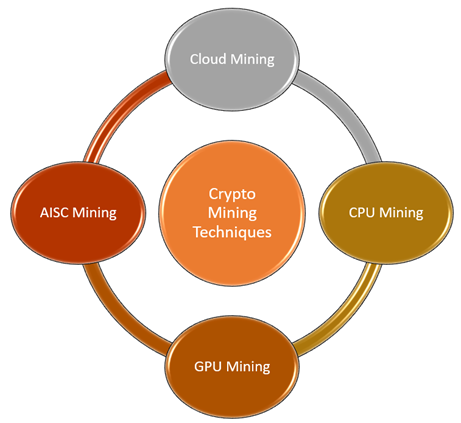Crypto Mining
Updated on 2023-08-29T12:00:38.184852Z
Crypto mining is the process of recovering cryptocurrencies by solving equations with the help of computers. The process of crypto mining involves the validation of data blocks and the addition of transaction records to a blockchain. In more technical terms, one can say that it is the process of solving more complex functions with the help of computers to record data into a blockchain. To better understand crypto mining, one first needs to understand what a cryptocurrency is and the basic difference between decentralised and centralised systems.
What is Cryptocurrency?

Copyright © 2020 Kalkine Media Pty Ltd
A cryptocurrency is a type of digital coinage that is encrypted with cryptography, making it impossible to counterfeit. Blockchains are an essential component of many cryptocurrencies that safeguards the integrity of transactions.
Difference between centralised and decentralised systems:
Traditional banks follow centralised systems that are used to control and maintain the centralised record. Every transaction has to enter into the central banking system, where it gets recorded and verified in layman terms. However, only a few banks have access to the direct, centralised banking systems, which makes it a restricted system.
On the flipside, cryptocurrencies follow a decentralised system, which doesn't have any central authority or a centralised record system. Cryptocurrencies follow a decentralised system, which is known as a blockchain.
Anyone can do a transaction without the involvement of a centralised body. In addition, to have a decentralised system, cryptocurrencies also have a distributed ledger system that allows users to have a transparent record or ledger book publicly available. Cryptocurrency users use cryptographic algorithms to authenticate the transactions before adding them to ledgers.
Cryptocurrency Mining Techniques:
There are various types of methods for the mining of cryptocurrencies, the most popular among all are illustrated below in brief:

Copyright © 2021 Kalkine Media Pty Ltd
- Cloud Mining: Cloud mining is the most popular method of crypto mining. In this process, one pays someone, mostly big firms, to lease out the rigs for mining. The interested party has to give some pre-agreed rent amount to the company for the time period. The cloud rig miners transfer the balance into your crypto wallet after deducting the maintenance and electricity costs. The companies which offer this type of services have huge mining infrastructure with multiple farms. The method is popular among miners who can't afford their own rigs.
- CPU Mining: CPU mining was a viable option to mine cryptocurrencies earlier, but very few people opt for this method. This is a very slow process. It may take months to mine the small amount of cryptocurrency, but the electricity charges and rig cooling costs may become higher. The process involves a computer and few computer programs to start the mining. However, the process is not advisable because it could harm your computer system. Instead, it will be a better option if you could find a relatively cool place with a cheap electricity supply to reduce the mining process cost.
- GPU Mining: GPU Mining is probably the most popular and cheap way of mining cryptocurrencies. However, the initial cost for the set up of a rig used to mine cryptocurrency is a bit higher, but when the rig comes to its hash speed, the GPU mining rig is superior. GPU rigs consist of graphic cards, motherboards, rig frame, processor and a cooling unit.
- AISC Mining: AISC stands for Application-Specific Integrated Circuit. AISC is a special device that is designed to perform a dedicated task. AISC produce a decent number of cryptocurrencies compared to CPU and GPU. The launch of the new version of AISC has created a buzz among crypto miners, and several people demanded these machines' ban. AISCs have the capability to easily rob the currencies of CPU and GPU miners easily.
Is Cryptocurrency Mining legal?
When we talk about general consideration, crypto mining is legal; however, it depends on the geographical location of mining and the process by which a miner mines cryptocurrency. As far as the miner is using legal methods, there is not an issue, but if a miner enters into illicit methods of mining, it comes under illegal activity. Some miners install malware on unsuspecting users' devices to hijack their systems and then mine cryptos for themselves.
However, the government across the world has different views on the mining of cryptocurrency. As of February 2020, Bitcoin was legal in Japan, the US, UK and other developed countries. The US has released guidelines for taxpayers. Russia, Vietnam, Bolivia, Columbia and Ecuador don’t consider Bitcoin as a legitimate payment method.
In addition to that, the use of Ethereum is banned in Afghanistan, Pakistan, Bangladesh, Bolivia, Algeria, Saudi Arabia and few other countries as well.
Types of Cryptocurrencies:
Bitcoin, Dash, Monero and Ethereum are among the few most popular cryptocurrencies in the world. However, there are thousands of other cryptocurrencies which exist in the world. There are more than 4,000 cryptocurrencies in the world as of January 2021. Beyond that, daily new additions are being made to the list.
Some of the popular cryptocurrencies other than Bitcoin are Ethereum (ETH), Litecoin (LTC), Cardano (ADA), Polkadot (DOT), Bitcoin Cash (BCH), Stellar (XLM), Chainlink, Binance Coin (BNB), Tether (USDT), Monero (XMR).
Why is Crypto Mining booming?
Since more people are getting familiar with cryptocurrencies and learning the mining process, more people are using computers to mine cryptocurrencies. With more people joining the race to become crypto miners, encryption becomes harder and requires more computing power with more electricity requirements.
In addition to that, people’s greed to use digital money with greater privacy controls of their money also fueled the mining momentum. The better-than-expected crypto market size in coming years with US$1 trillion crossed in January 2021 has also added to the mushrooming of crypto miners.